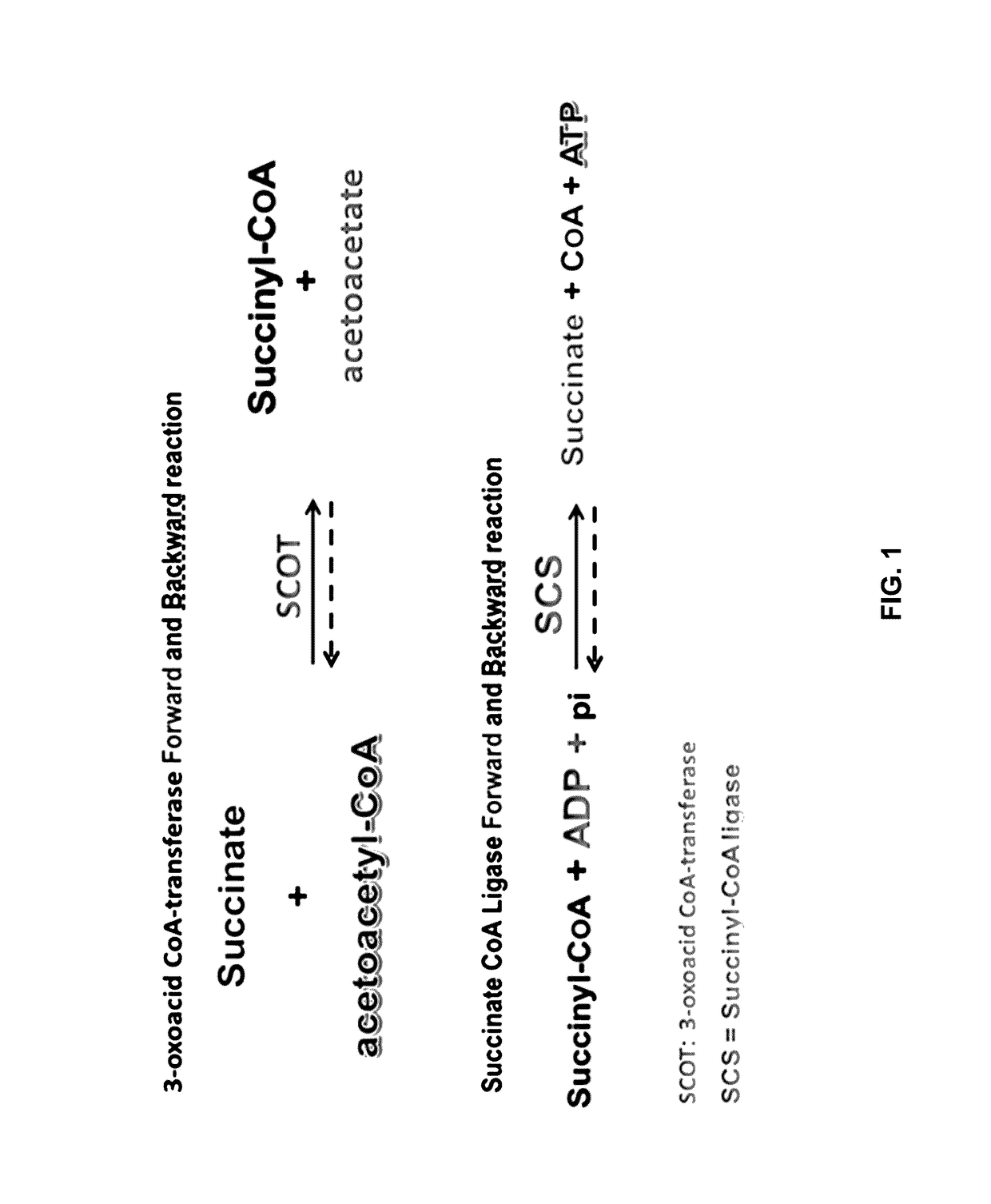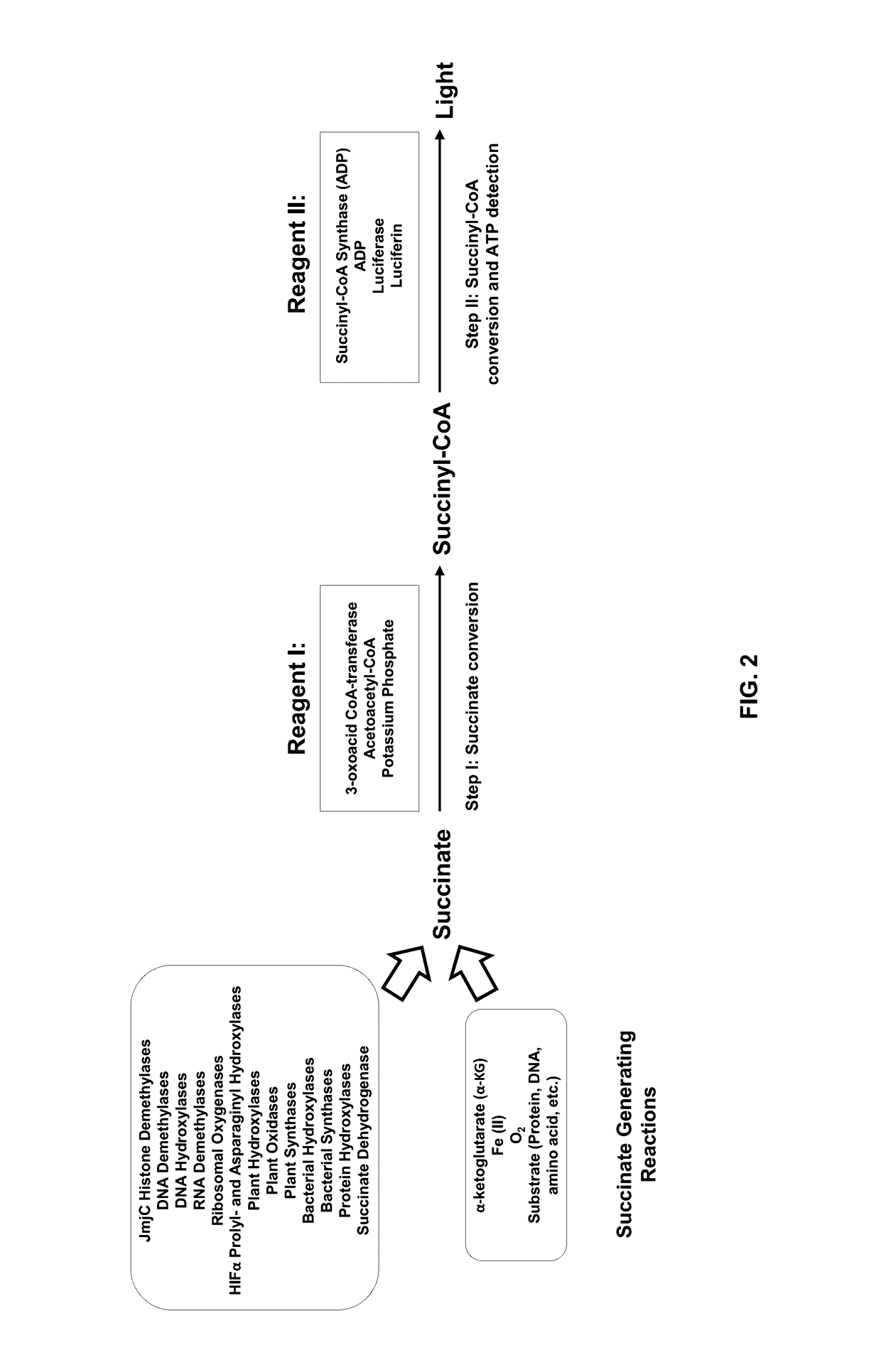Bioluminescent succinate detection assay
a technology of bioluminescent succinate and detection assay, which is applied in the direction of biological material analysis, instruments, biochemical equipment and processes, etc., can solve the problems of inconvenient rapid demethylase activity detection of assays, dysregulation of enzyme activity of these enzymes, and inability to quickly detect demethylase activity
- Summary
- Abstract
- Description
- Claims
- Application Information
AI Technical Summary
Problems solved by technology
Method used
Image
Examples
example 1
Materials
[0223]The following were used in the Examples described herein: 3-oxoacid CoA-transferase (UniProtKB / Swiss-Prot # Q29551); ADP-forming succinyl-CoA synthase (UniProtKB / Swiss-Prot #O19069 and O97580 for Sus scrofa SCS-ADP; UniProtKB / Swiss-Prot # P0A836 and P0AGE9 for E. coli SCS-ADP); Acetoacetyl-Coenzyme A sodium salt hydrate (Sigma Catalog number A1625); GDP-forming succinyl-CoA synthase (NCBI Reference Sequences: NP_999574.1 and XP_003132357.3); Sodium succinate dibasic (Sigma Catalog number 14160); α-Ketoglutarate potassium salt (Sigma Catalog number K2000); Ultra pure GTP (Promega); Coenzyme A trilithium salt (Sigma Catalog number C3019); Guanylate kinase (NCBI Reference Sequence: NP_001152884.1 and NP_001152885.1); Pyruvate kinase from rabbit skeletal muscle (Sigma Catalog number P9136); Phosphoenolpyruvate (Sigma Catalog number P7127); and Adenylate Cyclase (AC): a recombinant fragment of B. pertussis toxin that contains the active AC portion and demonstrated activity...
example 2
Cloning and Expression of 3-Oxoacid CoA-Transferase (SCOT) and Succinyl-CoA Synthetases (SCS-ADP and SCS-GDP)
[0226]The 3-Oxoacid CoA-Transferase gene of Sus scrofa was cloned as a synthetic codon-optimized sequence from Genscript. The expressed protein ranged from amino acid 40 to 517 and included an 8× His tag on the C-terminus. The protein was expressed in E. coli KRX cells (Promega) from the T7 promoter of Flexi vector pF1K (Promega). The KRX strain was grown in Terrific Broth at 25° C. and induced at an OD600=˜1.5 with 0.1% rhamnose. Growth at 25° C. continued overnight. The SCOT enzyme was purified over HisLink resin (Promega), and the purified eluate was dialyzed into 25 mM HEPES, pH 7.5, 25 mM NaCl, 1 mM DTT, and 50% glycerol. The size of the purified enzyme was verified via SDS-PAGE.
[0227]The Succinyl-CoA Synthetase alpha and beta subunit genes of Sus scrofa (SCS-ADP and SCS-GDP) were cloned as synthetic codon-optimized sequences from Genscript. The SCS alpha protein include...
example 3
Succinate Detection Assay Using 3-Oxoacid CoA Transferase and ADP-Forming Succinyl-CoA Synthase
[0229]The succinate detection assay in FIG. 2 was performed generally in two steps as follows. The succinate titration was performed in 25 μL containing 1× Demethylase Reaction Buffer (50 mM HEPES, pH 7.5, 0.01% Tween-20, 10 μg / mL BSA, 100 μM ascorbate, 10 μM Fe(II), 10 μM α-ketoglutarate). 25 μL of Bioluminescent Succinate Detection Reagent I was added to the succinate samples, and the mixture was incubated for 60 min at room temperature (˜23° C.). To detect succinyl-CoA, 50 μL of Bioluminescent Succinate Detection Reagent II was added, and the mixture was incubated for 60 min at room temperature before luminescence was detected on a luminometer. The succinate titration shown in FIG. 3 was performed in 96-well low volume plates (Corning Costar®, cat#3693).
PUM
| Property | Measurement | Unit |
|---|---|---|
| molecular weight | aaaaa | aaaaa |
| molecular weights | aaaaa | aaaaa |
| molecular weights | aaaaa | aaaaa |
Abstract
Description
Claims
Application Information
 Login to View More
Login to View More - R&D
- Intellectual Property
- Life Sciences
- Materials
- Tech Scout
- Unparalleled Data Quality
- Higher Quality Content
- 60% Fewer Hallucinations
Browse by: Latest US Patents, China's latest patents, Technical Efficacy Thesaurus, Application Domain, Technology Topic, Popular Technical Reports.
© 2025 PatSnap. All rights reserved.Legal|Privacy policy|Modern Slavery Act Transparency Statement|Sitemap|About US| Contact US: help@patsnap.com



